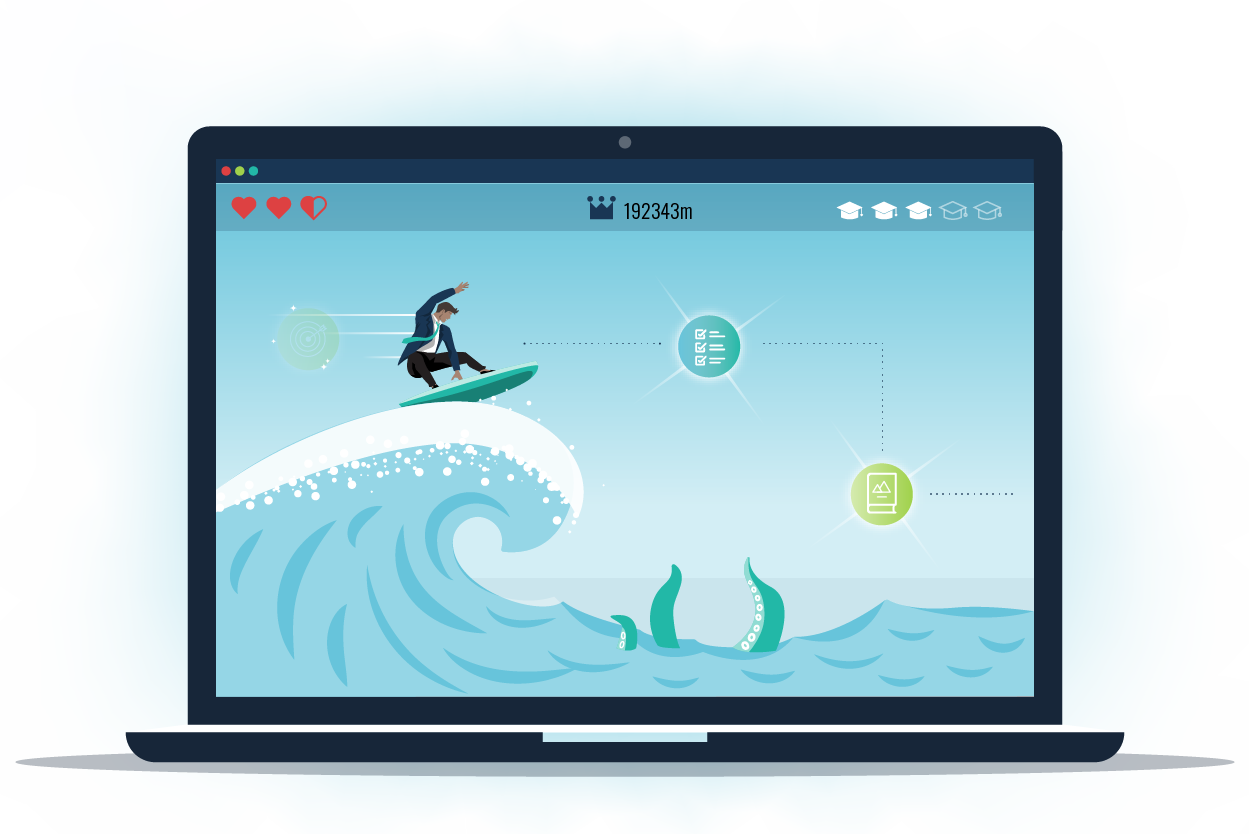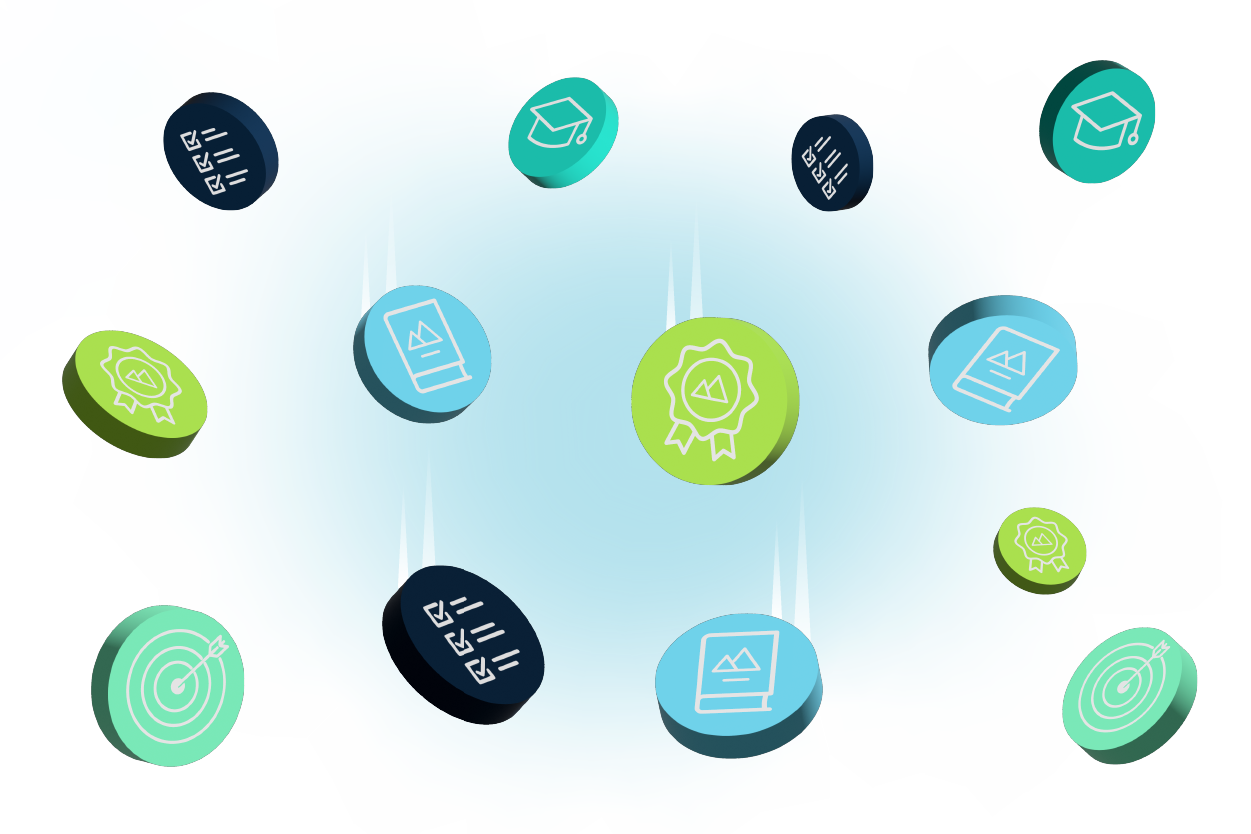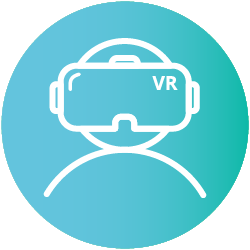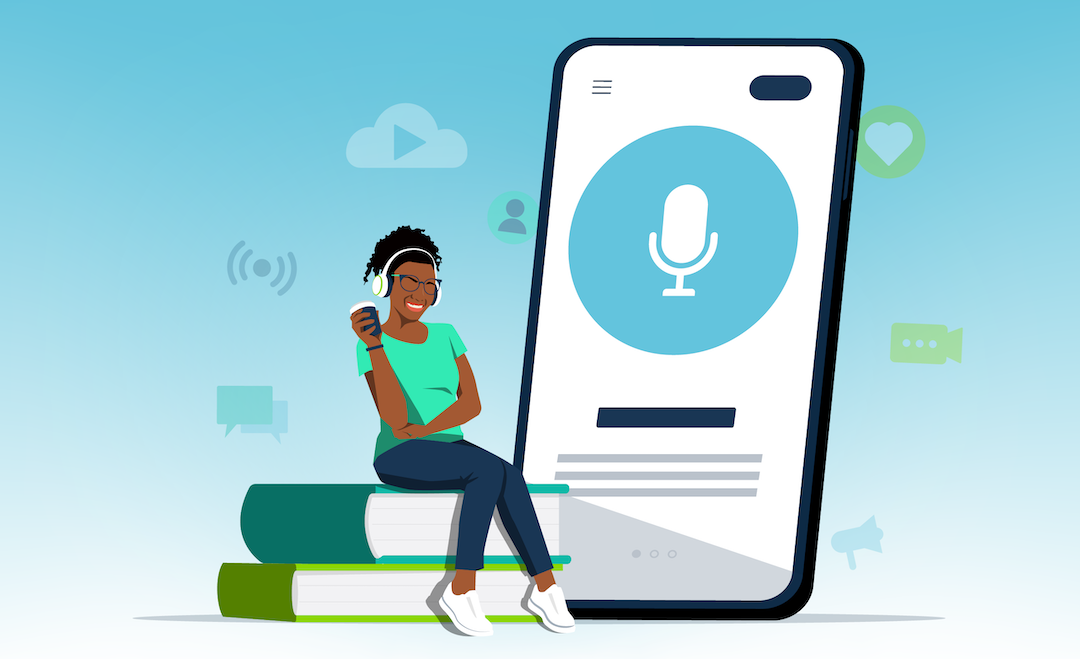
In 2018, Josh Bersin introduced the concept of ‘Learning in the Flow of Work’, marking a transformative shift in training paradigms. In an era characterised by time-pressed learners and ever-changing workplace demands, integrating learning into daily workflows seems like a natural response.
Indeed, 68% of learners prefer to train on the job. Despite this, when the CIPD surveyed learning professionals about their priorities, only 12% said ‘integrating learning within the flow of work’. What’s the cause of this misalignment?
We learn in the flow of life all the time. This happens every time you check the spelling of a word, or watch a ‘how to’ video on Youtube. There’s almost nothing we can’t find the answer to in the wide-expanse of the internet.
Unfortunately, when it comes to corporate learning, we keep finding new ways to add barriers between learners and their training content. There’s always another platform to login to, an app to download or a clunky interface to navigate.
The average employee only has 24 minutes a week for ‘formal learning’. Learning in the flow of work focuses on leveraging this time effectively to help close the gap between training and business outcomes.
In this article, we’ll delve into the concept of learning in the flow of work, tracing its origins, outlining its advantages and offering a simple guide to its implementation. We’ll also explore the role it should play within your broader learning programme.
Ready to go with the flow?
The Background
To fully grasp this paradigm shift, we must first understand what we’re shifting from. Industry analyst Josh Bersin contrasts the emerging concept of learning in the flow of work with the ‘Netflixication’ of corporate learning.
This is a model where vast libraries of categorised learning content are made readily available to learners. As a result, individuals can create their own learning paths through personal selection or via algorithm-generated recommendations.
However, as Josh Bersin notes, companies like Netflix are ‘often advertising-revenue driven’. As such, your engagement is the ultimate prize. Yet with learning, ‘we don’t want people to be addicted to the learning platform, we want them to learn something, apply it, and then go back to work.’
All of a sudden, we’re not talking about engagement, we’re talking about impact. What’s more, according to the 70:20:10 model, 70% of workplace learning happens on the job. Isn’t it time our training approaches took advantage of this?
What is Learning in the Flow of Work?

Learning in the flow of work (LITFOW) integrates learning seamlessly into the everyday tasks and workflows of your employees. This contrasts with traditional approaches that often involve separate, dedicated learning sessions or courses.
Imagine, for instance, that you’re working in a retail environment, trying to process a customer return. Scanning a QR code on the item with a portable device could display a step-by-step guide. This means you’re not left to figure things out by yourself.
This approach recognises that learning is most effective when it occurs in the context of work itself. After all, this allows individuals to acquire and apply new knowledge and skills in real time. Indeed, if it’s implemented correctly, LITFOW won’t feel like learning at all.
As Helen Tupper puts it, in the Harvard Business Review: “When individuals, teams and organisations find their learning flow, it becomes so embedded into daily routines and rituals that it’s no longer labelled as ‘learning’, and instead becomes an integral part of how work happens.”
The Key Principles of Learning in the Flow of Work
Learning in the flow of work intertwines learning with daily tasks, helping to foster continuous skill and knowledge enhancement. Let’s unravel the fundamental aspects that guide the integration of learning within the natural rhythm of work:
- Contextual Relevance: Learning in the flow of work is contextual by its nature. Learning happens mid-flow, meaning that it is directly related to the task, project or challenge at hand. This also means that any new knowledge or skills that are acquired are immediately applicable.
- Continuous: Traditional training approaches are finite entities. Classroom sessions end and there are only so many courses you can add to your learning platform. On the other hand, learning in the flow of work is a continuous process. After all, there’s always new tasks and learning opportunities to tackle.
- On-Demand: With a learning in the flow of work approach, your employees have access to learning resources and opportunities whenever they need them. This enables just-in-time learning experiences that address immediate needs or gaps in skills and knowledge.
- Push: Finding information on a learning platform often requires actively seeking it out. You may have to explore library categories or run a search. However, with a learning in the flow of work approach, this burden is alleviated. Relevant content is ‘pushed’ to your learners based on the context of their current task.
- Integrated: This approach seamlessly integrates learning into existing workflows and systems. In other words, learning prompts should occur within specific software or during relevant tasks. The goal is to eliminate the need for individuals to change their environment or switch focus in order to engage in learning activities.
Examples of Learning in the Flow of Work
Let’s delve into some compelling instances of learning in the flow of work. These examples showcase how integrating learning into your employee’s daily workflows can help to empower your workforce to meet their goals.
- Sales: Learning interventions could be seamlessly integrated into the workflow of your sales representatives through their customer relationship management (CRM) system. For instance, moving a ‘deal’ to a certain stage of their pipeline could prompt the user to complete a course in negotiation.
- Retail: In a retail setting, each display could feature a QR code. By scanning this code, retail professionals could instantly access product information, including unique selling points (USP) and recommended cross-selling or upselling options. This would help to improve customer satisfaction and sales numbers.
- Onboarding: During onboarding, QR codes could be placed strategically around the workplace, or within relevant documents. Scanning these codes should lead to instructional videos, interactive modules or digital manuals that help new starters to get to grips with your work environment and culture.
The Benefits of Learning in the Flow of Work
Learning in the flow of work offers a strategic approach to employee development that aligns with the demands of the modern workplace. With that said, let’s explore the benefits this approach brings in more detail.
1. Timely Application

If you believe the forgetting curve, then we forget 50% of everything we learn within a day. If you don’t use it, you’ll lose it. Learning in the flow of work allows learners to sidestep this issue by applying information immediately.
Application also reinforces knowledge, reducing the impact of memory decay over time. With only 12% of workers claiming they apply new skills learned to their jobs, it’s clear that learning in the flow of work could provide you with a real competitive advantage.
2. Improved Engagement

According to the CIPD’s 2023 Learning at Work report, the two main barriers for learning and development (L&D) teams are a ‘lack of learner time’ and a ‘lack of engagement’. This is clearly an issue we need to overcome.
However, if your content is valuable, informative and relevant, then it will naturally court an engaged audience. Learning in the flow of work can’t help but be all these things. After all, each learning intervention is contextually-generated.
This ensures that you capture your audience’s attention right where they are, aligning perfectly with their tasks and objectives. 91% of employees desire training that is relevant to their job roles and learning in the flow of work helps to fulfil this crucial need.
3. Improved Performance

Research has shown us that increased learner engagement typically leads to improved organisational performance. In fact, engagement has been shown to have a positive impact on productivity, innovation, retention, efficiency and many other crucial business metrics.
Furthermore, with relevant information always available, your employees will be empowered to perform at their best. Seamless access to knowledge helps to foster confidence and eliminates the excuse of not knowing something.
As Steve Glaveski, writing for the Harvard Business Review puts it, ‘people learn best when they have to learn’.
4. Employee Satisfaction

Learning in the flow of work also offers a number of advantages for individuals. According to a study by Josh Bersin, people who spend time learning at work are:
- 47% less likely to be stressed
- 39% more likely to feel productive
- 23% more ready to take on additional responsibilities
- And 21% more likely to feel happy
You can imagine the cumulative effect that each of these benefits would have for your learners. In turn, you can imagine the kind of impact this might have on your organisation.
5. Cost Savings

According to McKinsey, employees spend an average of 9.3 hours per week searching for information. That’s more than one working day per week spent not actively contributing to your organisation’s success.
With a learning in the flow of work approach, you can reclaim valuable time by delivering information to learners precisely when they need it. This means less time searching for relevant resources and more time applying newfound knowledge.
How to Implement Learning in the Flow of Work
Now that we’ve explored the concept of learning in the flow of work and its impressive effectiveness, you’re probably eager to begin implementing it within your organisation. In the following section, we’ll share some best practice tips to get you started.
1. Reduce Friction

As we’ve seen, the reason why learning in the flow of work is so effective is contextual relevance. As such, your first step should be to identify and eliminate any obstacles that might prevent your team from engaging in learning activities. This could include:
- Complex login procedures
- Clunky learning platforms
- Inaccessible content
- Or a lack of allocated time for learning
Simplifying access to your learning resources will enable your employees to access them as and when they need to. If your learners don’t need to jump through hoops to upskill themselves, they’ll start making an impact quicker than you might expect.
2. Make it Micro

Microlearning is a learning delivery approach that focuses on breaking information down into bite-size chunks. This approach fits perfectly within the flow of work, as employees can learn a new concept in a matter of moments and then apply it as necessary.
Conversely, if learning opportunities demand a substantial time investment, then employees are unlikely to pursue them during frontline or point-of-sale activities. Remember, you can always support your microlearning interventions with more in-depth content down the line.
3. Video Magic

Research indicates that we process visuals up to 600 times faster than text. This efficiency makes video an indispensable tool for achieving immediate engagement, particularly if you’re operating at the point of sale.
Video is also a perfect fit for your microlearning strategy, as you’re able to communicate more effectively by appealing to multiple senses at once. This characteristic ensures that video content will slot neatly into your learning in the flow of work strategy.
4. Ensure Relevance

For learning to be truly effective, it must first be relevant to the employee’s current role and responsibilities. With this in mind, you should ensure that all your content is focused and serves a specific purpose.
This can be accomplished by conducting a training needs analysis and setting precise learning objectives for all your content. Doing so will enable you to align your training materials with specific contextual requirements.
5. Leverage Your LMS

There’s a good chance that your organisation already uses a learning management system (LMS). These platforms are traditionally used to support formal training programmes, but they also offer a significantly wider reach.
For instance, you can integrate your LMS with other business applications to provide easy access to your content within other platforms. With this approach, you could deliver targeted customer service training based on real-time interactions within a CRM system.
Alternatively, you could connect to communication tools such as Slack or Teams to enable easy knowledge sharing and compliance training reminders. Certain learning systems even offer browser extensions that actively monitor web activities to suggest relevant learning interventions.
6. Go Mobile

Let’s not forget that 80% of today’s workforce is deskless. Despite this, your frontline workers still require access to just-in-time learning experiences. After all, they’re the individuals at the coalface and they have a significant impact on your bottom line.
In light of this, it’s essential that your content is mobile-friendly and accessible via smartphones and tablets (ideally without a login). This flexibility facilitates on-the-go learning and enables employees to swiftly access vital information.
7. QR Codes

QR codes excel at enabling context-specific learning opportunities. By embedding QR codes throughout your physical workspace or documentation, you can facilitate instant access to relevant training interventions.
For instance, scanning a QR code next to a piece of equipment could open up a short tutorial or safety guidelines. Similarly, incorporating a QR code within your company handbook could unlock an engaging message from your CEO.
8. Get Immersive

For more complex skills or processes, you might even consider using Virtual Reality (VR) or Augmented Reality (AR) to provide access to immersive learning experiences. These technologies can simulate real-world scenarios, allowing learners to hone their skills in a safe environment.
For example, Porsche has embraced AR technology to revolutionise its service operations. By scanning vehicle components, technicians can instantly access remote guidance. This facilitates quicker problem resolution and improves their level of service.
Learning in the Flow of Work: A True Paradigm Shift?
With our implementation strategy in place, it’s time to reflect on the significance of this shift in learning methodology. Should we bid farewell to centralised learning platforms and roll-out the red carpet for a new era in education?
Here at Growth Engineering, we believe that ‘learning in the flow of work’ is just part of the organisational learning puzzle. Learning is a lifelong pursuit. It can and should happen both inside and outside of the flow of work.
Indeed, despite what you might have heard, learning platforms won’t truly ‘die’ until the final spark of human curiousity has been snubbed out. If all learning was triggered only by momentary needs, we would be an entirely determined product of our environment.
These sort of behaviourist views aren’t very popular any more. Your learners should be self-determined and have the autonomy to explore and ‘pull’ knowledge from your training library. This will enable them to shape their own growth trajectory.
After all, some subjects or skills require deep focus and uninterrupted study time. This is not compatible with the bite-sized nature of LITFOW. These types of learning experiences also often fail to cater to diverse learning needs and preferences.
There’s also something to be said for focus. LITFOW requires regular context-switching, which can be mentally taxing. Indeed, according to psychologist Gerald Weinberg, each extra ‘context’ you switch eats up to 20-80% of your overall productivity.
While learning in the flow of work is an innovative and effective approach, it’s important that it is integrated effectively within a holistic learning strategy. Ultimately, your aim should be to create a balanced and inclusive learning environment that nurtures continuous growth.
Final Words
Learning in the flow of work erases the boundaries that separate learners from the knowledge they need. This empowers your team to access insights when they’re most relevant, instead of after the fact. The line between learning and application has never been blurrier.
This methodology naturally resonates with adult learning principles, which foreground experiential learning, social interaction, and tackling real-world challenges. The need to get something done can be a powerful learning motivator.
We’re not usually ones to go against the flow (so to speak), but we would encourage you to integrate this approach as part of a broader educational framework. Access to learning is crucial, but you should also encourage learners to forge their own paths.
The potential benefits of embedding learning into everyday work are substantial. Creating an environment where learning is as instinctive as breathing can unlock the full potential of your workforce. That way, you’ll always be ready for the challenges that lie ahead.
Thank you for reading. Learning in the flow of work is just one approach to organisational learning & development. To get the full breakdown, please download ‘The L&D Professional’s Handbook’ now.









